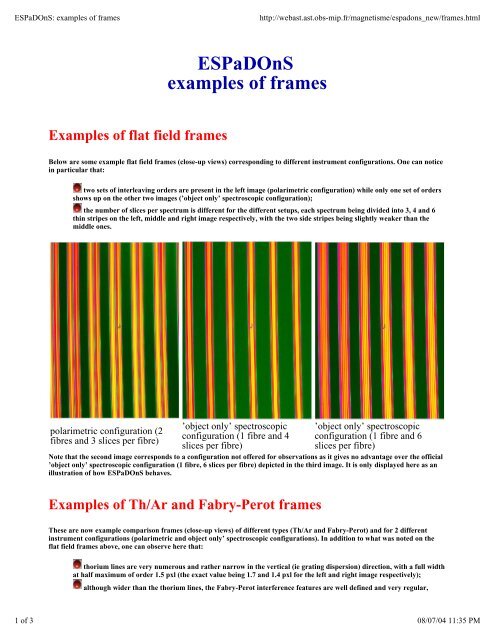CFHT operating manual - Homepage Usask
CFHT operating manual - Homepage Usask
CFHT operating manual - Homepage Usask
You also want an ePaper? Increase the reach of your titles
YUMPU automatically turns print PDFs into web optimized ePapers that Google loves.
ESPaDOnS: examples of frames http://webast.ast.obs-mip.fr/magnetisme/espadons_new/frames.html<br />
Examples of flat field frames<br />
polarimetric configuration (2<br />
fibres and 3 slices per fibre)<br />
ESPaDOnS<br />
examples of frames<br />
Below are some example flat field frames (close-up views) corresponding to different instrument configurations. One can notice<br />
in particular that:<br />
two sets of interleaving orders are present in the left image (polarimetric configuration) while only one set of orders<br />
shows up on the other two images (’object only’ spectroscopic configuration);<br />
the number of slices per spectrum is different for the different setups, each spectrum being divided into 3, 4 and 6<br />
thin stripes on the left, middle and right image respectively, with the two side stripes being slightly weaker than the<br />
middle ones.<br />
’object only’ spectroscopic<br />
configuration (1 fibre and 4<br />
slices per fibre)<br />
’object only’ spectroscopic<br />
configuration (1 fibre and 6<br />
slices per fibre)<br />
Note that the second image corresponds to a configuration not offered for observations as it gives no advantage over the official<br />
’object only’ spectroscopic configuration (1 fibre, 6 slices per fibre) depicted in the third image. It is only displayed here as an<br />
illustration of how ESPaDOnS behaves.<br />
Examples of Th/Ar and Fabry-Perot frames<br />
These are now example comparison frames (close-up views) of different types (Th/Ar and Fabry-Perot) and for 2 different<br />
instrument configurations (polarimetric and object only’ spectroscopic configurations). In addition to what was noted on the<br />
flat field frames above, one can observe here that:<br />
thorium lines are very numerous and rather narrow in the vertical (ie grating dispersion) direction, with a full width<br />
at half maximum of order 1.5 pxl (the exact value being 1.7 and 1.4 pxl for the left and right image respectively);<br />
although wider than the thorium lines, the Fabry-Perot interference features are well defined and very regular,<br />
1 of 3 08/07/04 11:35 PM

















